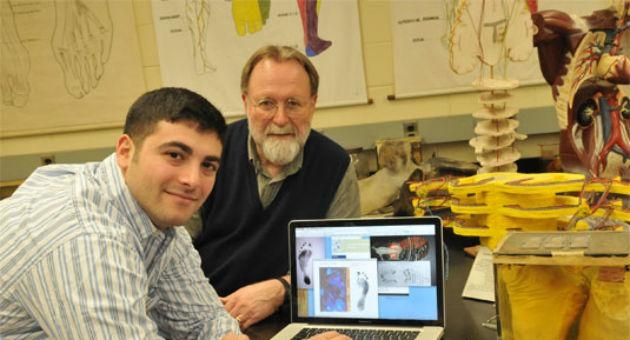Forensic podiatry club offers students a new way to think about feet

As a high school senior in 2003, Mike Sganga took a course in forensics — the art of crime solving — and discovered an interest that stayed with him as he began his studies in Temple’s School of Podiatric Medicine.
But Sganga’s curiosity about solving crimes soon took a backseat to exams and clinical rotations — until the Fall 2009 semester, when he took an anatomy course taught by Arthur Washburn, an associate professor of anatomy and cell biology in Temple’s School of Medicine.
For the past 20 years, Washburn has served as a forensic consultant to the Philadelphia Medical Examiner’s Office, often called to examine human skeletal remains to determine a victim’s age, gender and ethnicity. After learning of Washburn’s work with the city, Sganga and classmate Ronald Dirlam shared their interest in forensics, and asked the professor if they could accompany him on his next case. When the next call came, Washburn agreed to let Sganga and Dirlam tag along
“We met at the Medical Examiner’s office to examine some bones that were found at a crime scene,” Sganga said. “We were able to do systematic measurements and determine the age, gender and ethnicity based on the length and thickness of the bones.”
Sganga wondered why there wasn’t a formal course on forensics at any of the podiatry schools in the U.S., and with Washburn’s help, decided to remedy that by starting the first club in the country dedicated to learning how podiatrists can help process crime scenes.
“Forensic podiatry is still a relatively new field,” said John DiMaggio, president of the American Society of Forensic Podiatry, which began in 2003. “But it makes sense if you’re trying to process a crime scene to look at things like foot prints or shoes that have been left behind. If someone walks into a crime scene, someone has to walk out.”
DiMaggio says a recent murder case in England was solved by comparing a suspect’s gait to one captured on surveillance video, and several rape cases have been solved by having a forensic podiatrist examine the lining of shoes left at a crime scene.
“Podiatrists are trained to look at bones for pathological features, so they can look at the impressions of a shoe lining and determine whether the suspect had a bunion or hammertoe, and can show in court how they can leave distinctive marks,” he said.
In the case they worked on with Washburn, Sganga and Dirlam were able to help identify the victim by comparing their findings to a driver’s license found at the scene and sending the data to a forensic dentist, who confirmed the identity through dental records.
So far, the forensic podiatry club at Temple has had two meetings with about 60 people attending in total. At the most recent, Washburn lectured on identifying bones at a crime scene. But Sganga says he doesn’t want to stop at lectures.
“We certainly want to talk to other experts in the field to learn things like how to prepare a deposition, but we’d also like to do workshops at Temple’s Gait Lab so we can learn how to study unique gait patterns and hopefully even visit the medical examiner’s office and go out into the field, the way we did with Dr. Washburn,” he said.
As faculty advisor, Washburn says he sees the club as a way to expand the discipline of forensics. “In order to blossom, podiatrists need to be able to carve out a niche like some of the other subspecialties in forensics, such as engineering or anthropology,” he said.
“Being the first club of its kind in the country, I think it’s a great idea, and is very important,” said DiMaggio. “It will lead to a discussion and get students thinking about new ways to contribute to the field of podiatry.”
— Renee Cree